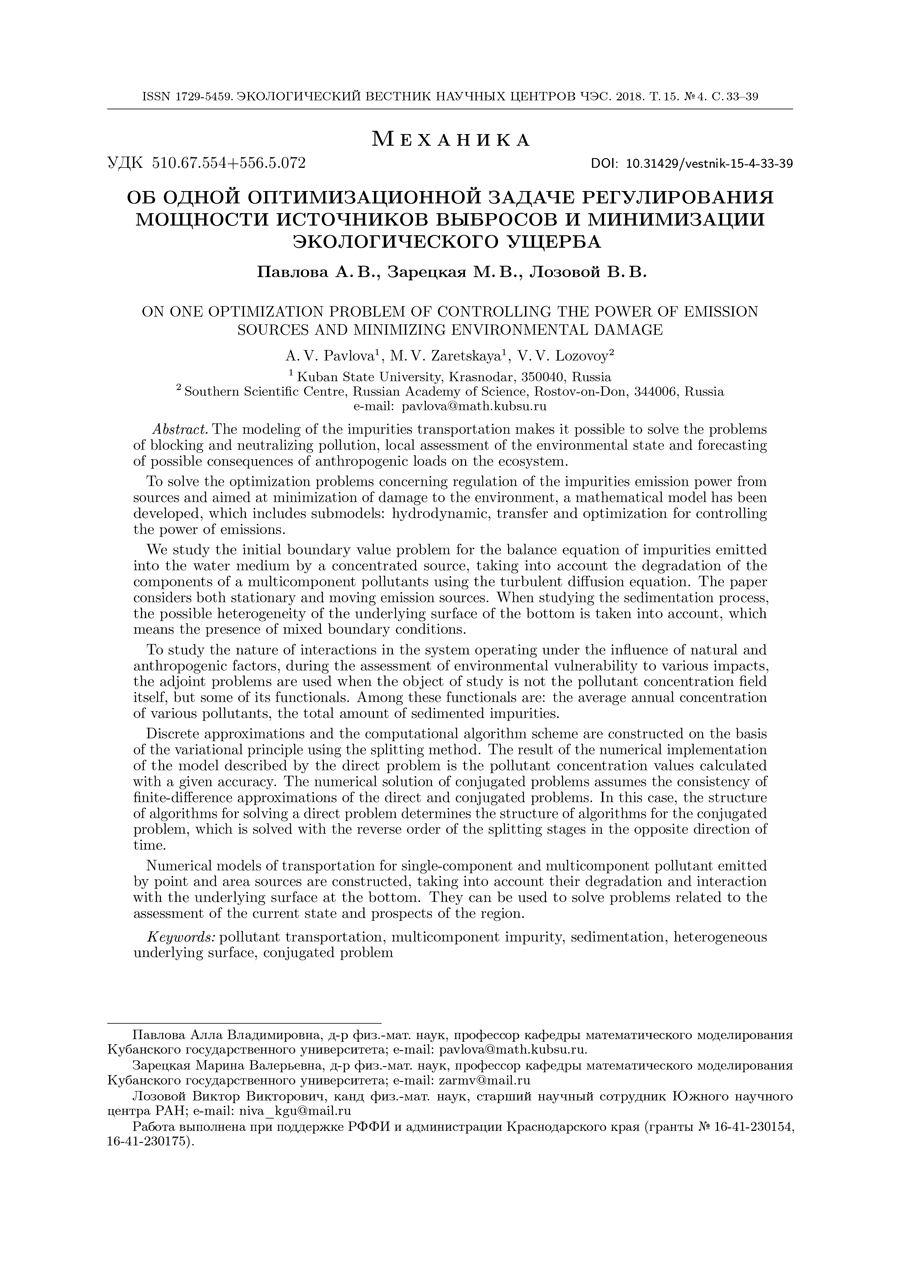On one optimization problem of controlling the power of emission sources and minimizing environmental damage
UDC
510.67.554+556.5.072DOI:
https://doi.org/10.31429/vestnik-15-4-33-39Abstract
The modeling of the impurities transportation makes it possible to solve the problems of blocking and neutralizing pollution, local assessment of the environmental state and forecasting of possible consequences of anthropogenic loads on the ecosystem.
To solve the optimization problems concerning regulation of the impurities emission power from sources and aimed at minimization of damage to the environment, a mathematical model has been developed, which includes submodels: hydrodynamic, transfer and optimization for controlling the power of emissions.
We study the initial boundary value problem for the balance equation of impurities emitted into the water medium by a concentrated source, taking into account the degradation of the components of a multicomponent pollutants using the turbulent diffusion equation. The paper considers both stationary and moving emission sources. When studying the sedimentation process, the possible heterogeneity of the underlying surface of the bottom is taken into account, which means the presence of mixed boundary conditions.
To study the nature of interactions in the system operating under the influence of natural and anthropogenic factors, during the assessment of environmental vulnerability to various impacts, the adjoint problems are used when the object of study is not the pollutant concentration field itself, but some of its functionals. Among these functionals are: the average annual concentration of various pollutants, the total amount of sedimented impurities.
Discrete approximations and the computational algorithm scheme are constructed on the basis of the variational principle using the splitting method. The result of the numerical implementation of the model described by the direct problem is the pollutant concentration values calculated with a given accuracy. The numerical solution of conjugated problems assumes the consistency of finite-difference approximations of the direct and conjugated problems. In this case, the structure of algorithms for solving a direct problem determines the structure of algorithms for the conjugated problem, which is solved with the reverse order of the splitting stages in the opposite direction of time.
Numerical models of transportation for single-component and multicomponent pollutant emitted by point and area sources are constructed, taking into account their degradation and interaction with the underlying surface at the bottom. They can be used to solve problems related to the assessment of the current state and prospects of the region.
Keywords:
pollutant transportation, multicomponent impurity, sedimentation, heterogeneous underlying surface, conjugated problemAcknowledgement
References
- Marchuk, G.I. Matematicheskoe modelirovanie v probleme okruzhayushchey sredy [Mathematical modeling in environmental issues]. Nauka, Moscow, 1982.
- Penenko, V.V., Aloyan, A.E. Modeli i metody dlya zadach okhrany okruzhayushchey sredy [Models and methods for environmental issues]. Nauka, Novosibirsk, 1985.
- Aloyan, A.E. Modelirovanie dinamiki i kinetiki gazovykh primesey i aerozoley v atmosfere [Modeling the dynamics and kinetics of gas impurities and aerosols in the atmosphere]. Nauka, Moscow, 2008.
- Pavlova, A.V., Kalajdin, V.V. Ob odnoy modeli rasprostraneniya zagryaznyayushchey primesi ot ploshchadnogo istochnika [On one model of the distribution of pollutants from an areal source]. Zashhita okruzhajushhej sredy v neftegazovom komplekse [Environmental protection in the oil and gas sector], 2012, no. 2, pp. 18–22.
- Babeshko, V.A., Zareckaya, M.V., Evdokimova, O.V., Pavlova, A.V., Babeshko, O.M., Kruglyakova, O.P., Kurilov, P.I., Terenozhkin, A.M., Gendina, I.V. Otsenka vliyaniya vulkanicheskikh i prirodno-tekhnologicheskikh zagryazneniy na ekosistemu Azovskogo morya [Assessment of the impact of volcanic and natural-technological pollution on the ecosystem of the Azov Sea]. Zashhita okruzhajushhej sredy v neftegazovom komplekse [Environmental protection in the oil and gas sector], 2010, no. 9, pp. 6–12.
- Zareckaya, M.V., Babeshko, V.A., Ratner, S.V. Modelirovanie protsessa perenosa v vodnoy srede produktov gryazevulkanicheskoy deyatel'nosti [Modeling of the process of transferring the products of mud volcanic activity in the aquatic environment]. Zashhita okruzhajushhej sredy v neftegazovom komplekse [Environmental protection in the oil and gas sector], 2008, no. 11, pp. 27–29.
- Shashin, V.M. Gidromekhanika [Hydromechanics]. Vysshaya shkola, Moscow, 1990.
- Berdnik, S.V., Pavlova, A.V. Modelirovanie perenosa i osazhdeniya zagryaznyayushchikh veshchestv s uchetom landshaftnykh osobennostey territorii [Modeling the transport and deposition of pollutants taking into account the landscape features of the territory]. Ecological Bulletin of Scientific Centers of the Black Sea Economic Cooperation, 2006, Spec. Iss., pp. 62–64.
- Babeshko, V.A., Babeshko, O.M., Evdokimova, O.V., Zareckaya, M.V., Pavlova, A.V., Fedorenko, A.G. O differentsial'nom metode faktorizatsii v prilozheniyakh [On the differential method of factorization in applications]. Ecological Bulletin of Scientific Centers of the Black Sea Economic Cooperation, 2008, no. 2. pp. 5–12.
- Babeshko, V.A., Evdokimova, O.V., Babeshko, O.M., Zareckaya, M.V., Pavlova, A.V., Muhin, A.S., Lozovoj, V.V., Fedorenko, A.G. O prilozheniyakh teorii blochnykh struktur v naukakh o zemle, seysmologii, stroitel'stve, materialovedenii [On applications of the theory of block structures in Earth sciences, seismology, construction, materials science]. Ecological Bulletin of Scientific Centers of the Black Sea Economic Cooperation, 2008, no. 4, pp. 27–34.
- Vabeshko, V.A., Zareckaya, M.V., Ryadchikov, I.V. K voprosu modelirovaniya protsessov perenosa v ekologii, seysmologii i ikh prilozheniya [On the issue of modeling of transfer processes in ecology, seismology and their applications]. Ecological bulletin of scientific centers of the Black Sea Economic Cooperation, 2008, no. 3, pp. 20–25.
Downloads
Submitted
Published
How to Cite
Copyright (c) 2018 Pavlova A.V., Zaretskaya M.V., Lozovoy V.V.

This work is licensed under a Creative Commons Attribution 4.0 International License.




